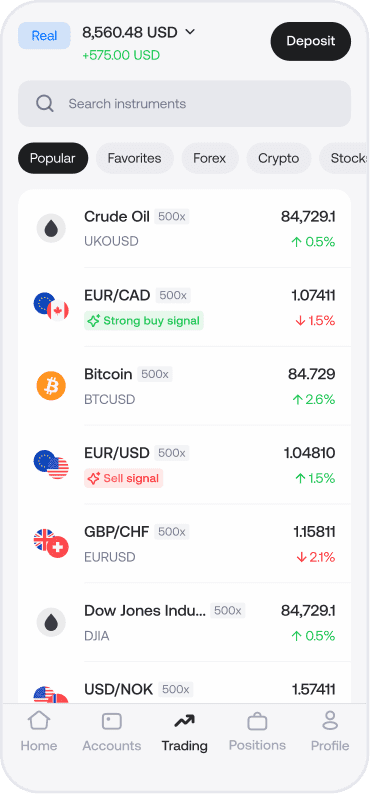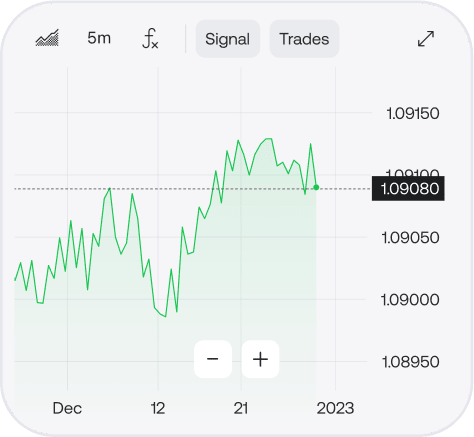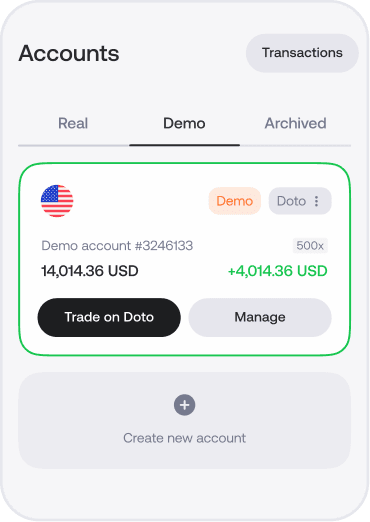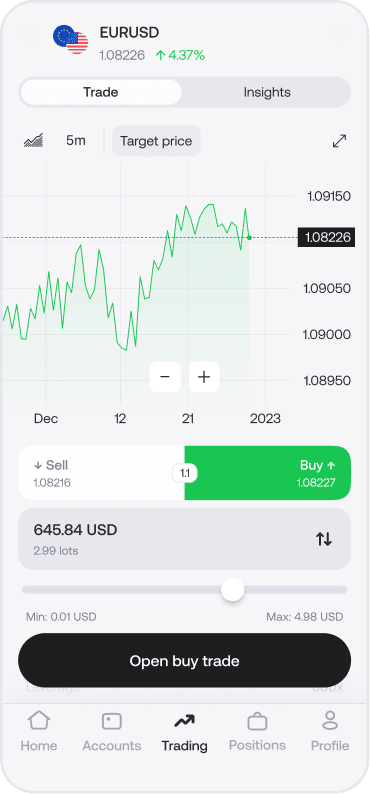Trading basics
From zero to trading hero

Trading is all about making money from price changes in things like crypto, stocks, currencies and more. The idea is simple: buy low, sell high.
🌟 Amazing fact: If a trader had placed a $100 up trade on Bitcoin with 100x leverage on Jan. 1, 2024 and closed it a year later, the potential profit would have been over $5,390!
That’s the power of CFD trading. Ready to dive in? Let’s go!
Trading basics
What is CFD trading?
CFD stands for “contract for difference.” You don’t actually own the instrument — you just make a contract with a broker (like Doto) about where you think the price will go.
 Think the price will rise? You open a buy trade
Think the price will rise? You open a buy trade Think it’ll drop? You open a sell trade
Think it’ll drop? You open a sell trade
If your prediction is correct, you pocket the difference in price. The best part? You can capitalize on both rising and falling markets!


Trading basics
A broker — Your gateway to the market
You can’t trade directly on the market without a broker. They handle all the technical stuff behind the scenes, like connecting you to global exchanges and making sure your trades run smoothly.
💫 At Doto, we do more than just execute trades — we provide insights and tips to help you make smarter decisions on 1,000+ financial instruments!

Trading basics
What can you trade?
On Doto, you can trade a wide range of instruments:
- Cryptocurrencies: Bitcoin, Ethereum and other digital currencies
- Forex: Currency pairs like EURUSD and GBPJPY
- Stocks: Shares of companies like NVIDIA, Tesla, Apple and more
- Commodities: Gold, silver, oil and other natural resources
- Indices: Major stock indices like the S&P 500 or Nasdaq

Trading basics
How to read instrument names
📉 Forex, crypto and commodities are usually shown as pairs or symbols:
Forex: EURUSD, GBPJPY — the first currency (base) is valued against the second (quote)
Crypto: BTCUSD, ETHBTC — similar to forex, these show how much one asset is worth in another
Commodities: XAUUSD (gold), UKOUSD (Brent oil) — measured against the listed currency
📈 Stocks and indices are expressed in tickers:
Stocks: AAPL (Apple), TSLA (Tesla) — each company has its own unique abbreviation
Indices: S&P 500 (US500), Nasdaq 100 (US100) — these represent a group of stocks, showing market performance
Trading basics
Trading terminal: Your control center
This is your trading terminal. Let's break it down:
- Instrument name, price and 24-hour change: See the basics at a glance

- Chart: The main tool for tracking price movements

- Trade buttons: Wondering why there are two prices here? Press Next to find out!

- Instrument name, price and 24-hour change: See the basics at a glance
Trading basics
Bid, ask and spread
Every instrument has two prices, kinda like a currency exchange at a bank. Here’s the deal.
- Bid (sell price): The price buyers are willing to pay (you sell at this price)
- Ask (buy price): The price sellers want (you buy at this price)
The difference between these two is called the spread — this is the fee for processing your trade. That’s how brokers make money.
Spreads are measured in pips, which brings us to the next topic.

Trading basics
What is a pip?
A pip is the smallest unit of change in a price.
For most currency pairs, a pip is the fourth number after the decimal.
📏 Example: If EURUSD moves from 1.1000 to 1.1001, that’s a change of 1 pip.
For other instruments, like gold, indices and some cryptocurrencies, a pip is the first number after the decimal.
📏 Example: If BTCUSD moves from 100,000.1 to 100,000.2, that’s a change of 1 pip.

Now you know the basics of trading! So, let’s start practicing on a demo account.
Trading basics
Demo account: Your safe space
Why start with a demo account? Simple:
- Zero risk. Trade with virtual money and no stress
- Real market conditions. Watch live price action in real time
- Hands-on practice. Get comfy with the platform and tools
- Confidence boost. Test strategies, make mistakes and learn without losing a cent

Trading basics
Let’s open a demo trade
Simply follow these steps:
- Pick any instrument you like
- Forecast its price direction and press Buy or Sell
- Press Open trade
Boom — you just made a trade!
📍 Spoiler: Doto also offers trading signals to help you forecast market moves more accurately. More on that soon!

Trading basics
Quick quiz: Test your knowledge
Imagine you’re trading on USDJPY, and the price starts falling. What does that mean?
Trading basics
Summing up
Congrats! You finished the first lesson. Now you know:
- What CFD trading is
- What instruments you can trade
- What bid, ask, spread and pips are
- How to start trading with a demo account
Next up, we’ll explore why you don’t need a big budget to start trading — it’s all thanks to leverage. Ready? Let’s go!